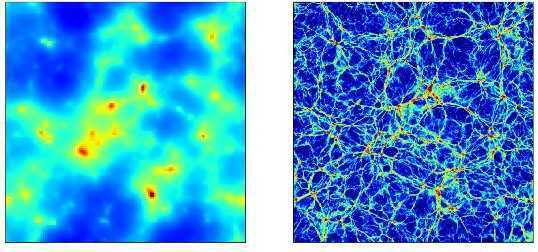The effect that nearly massless, subatomic particles called neutrinos have on the formation of galaxies has long been a cosmological mystery — one that physicists have sought to measure since discovering the particles in 1956.
But an international research team has created cosmological simulations that accurately depict the role of neutrinos in the evolution of the universe in a study recently published in The Astrophysical Journal.
Missouri University of Science and Technology cosmologist Dr. Shun Saito, an assistant professor of physics and researcher on the team, says the work is a milestone in the process of simulating the formation of the structure of the universe.
The team used a system of differential equations known as the Vlasov–Poisson equations to explain how neutrinos move through the universe with different values assigned to their mass. The technique accurately represented the velocity distribution function of the neutrinos and followed its evolution over time. The researchers then examined the effects of neutrinos on galaxy formation and evolution.
Their results showed that neutrinos suppress the clustering of dark matter – the undefined mass in the universe – and in turn, galaxies. They found that neutrino-rich regions are strongly correlated with massive galaxy clusters, and that the effective temperature of the neutrinos varies substantially depending on the mass of the neutrino.
The researchers say that the most stringent experiments used to estimate neutrino mass are cosmological observations, but those can only be relied upon if simulation predictions are accurate.
“Overall, our findings are consistent with both theoretical predictions and the results of previous simulations,” says Dr. Kohji Yoshikawa, lecturer in the Center for Computational Sciences at the University of Tsukuba and lead author of the study. “It is reassuring that the results from entirely different simulation approaches agree with each other.”
“Our simulations are important because they set constraints on the unknown quantity of the neutrino mass,” says Saito. “Neutrinos are the lightest particles we know of. We only recently learned neutrinos have mass from the discovery featured in the 2015 Nobel Prize in physics.”
That prize awarded two scientists for their separate discoveries that one kind of neutrino can change into another, which showed that neutrinos have mass.
“Our work might ultimately lead to a robust determination of the neutrino mass,” Saito says.
Other researchers in the study, “Cosmological Vlasov–Poisson Simulations of Structure Formation with Relic Neutrinos: Nonlinear Clustering and the Neutrino Mass,” are Dr. Naoki Yoshida, professor of physics at the University of Tokyo, and Dr. Satoshi Tanaka, a postdoctoral fellow at the Yukawa Institute for Theoretical Physics at Kyoto University.
Saito plans to incorporate the team’s research into the galaxy mapping studies he conducts as part of Missouri S&T’s membership in the Hobby-Eberly Telescope Dark Energy Experiment (HETDEX).
In association with HETDEX, S&T’s astronomical research team contributes to the exploration of the universe through research in gravitational waves, fundamental physics and cosmology.
About Missouri University of Science and Technology
Founded in 1870 as the University of Missouri School of Mines and Metallurgy, Missouri University of Science and Technology (Missouri S&T) is a STEM-focused research university of over 7,600 students and part of the four-campus University of Missouri System. Located in Rolla, Missouri, Missouri S&T offers 99 different degree programs in 40 areas of study, including engineering, education, the sciences, business and information technology, the humanities, and the liberal arts. Missouri S&T is known globally and is highly ranked for providing a high return on tuition investment, exceptional career opportunities for graduates, and an emphasis on applied, hands-on learning through student design teams and cooperative education and internship opportunities. For more information about Missouri S&T, visit www.mst.edu.
